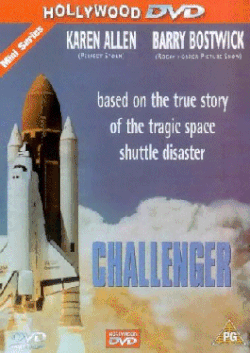| Challenger | |
|---|---|
 DVD release cover | |
| Genre | Disaster docudrama |
| Written by | George Englund |
| Directed by | Glenn Jordan [1] |
| Starring | Karen Allen Barry Bostwick Richard Jenkins Joe Morton Keone Young Brian Kerwin Julie Fulton Kale Browne Kristin Bond Angela Bassett |
| Composer | David E. Kole |
| Country of origin | United States |
| Original language | English |
| Production | |
| Producers | George Englund [2] [3] [4] Courtney Pledger Debbie Robins [5] |
| Production locations | Houston, Texas [6] |
| Cinematography | Newton Thomas Sigel |
| Editor | Paul Rubell |
| Running time | 135 minutes |
| Production companies | King Phoenix Entertainment The IndieProd Company |
| Original release | |
| Network | ABC [7] [8] |
| Release | February 25, 1990 [9] |
Challenger is a 1990 American disaster drama television film based on the events surrounding the Space Shuttle Challenger disaster in 1986. Its production was somewhat controversial [10] as the families [11] [12] of the astronauts generally objected to it. [13] [14] [15] [16] A prologue states [17] that the film was "researched with the consultation of the National Aeronauts and Space Administration" [18] and partly filmed at NASA's Johnson Space Center [19] [20] in Houston, Texas.


